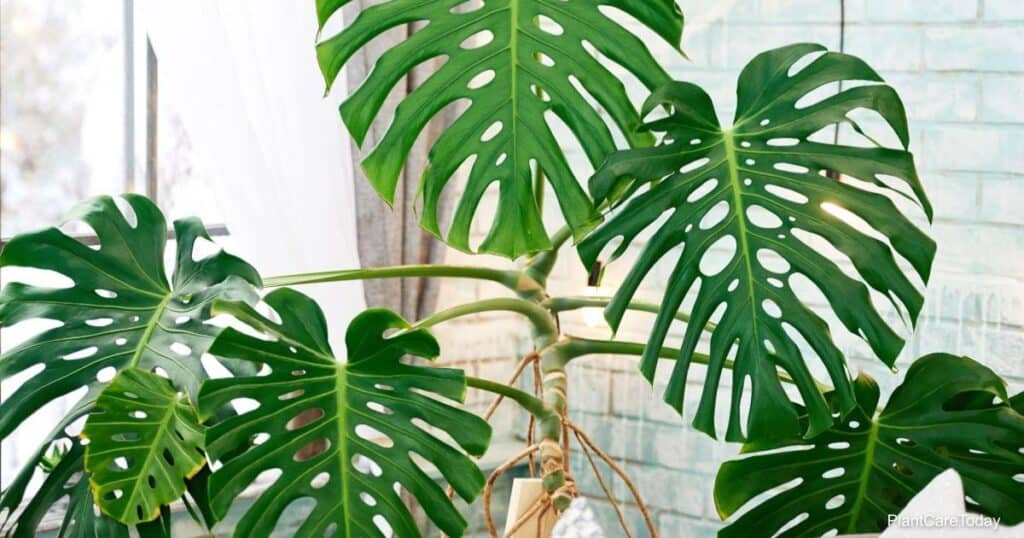The most common reason for brown spots on Monstera plant leaves is overwatering.
Too much water can cause root rot, and one symptom of root rot is very dark brown spots on leaves.

You may remedy this problem by simply adjusting your watering schedule.
However, in some cases, it is necessary to remove the plant from its pot, clean and prune the roots, and repot
It is essential to use an entirely new, clean potting mix and a new or sterilized container with plenty of drainages.
Follow-up with a systemic fungicide may also be necessary.
Correct Care Will Prevent Brown Spots On Monstera Leaves
It’s important to understand that Monstera is a remarkably hardy, easy-care plant. It takes very little to keep them hale and hardy.
In fact, they are generally happy in a typical household setting, as long as consistent warmth, average humidity, moderate light, and judicious watering and fertilizing are provided.
Extremes in any of these categories are likely to brown on leaves.
Follow the tips below to keep your Monstera happy.
Get The Sunlight Just Right
Monstera plants grow in a jungle setting in the wild, so they like to have plenty of bright, indirect sunlight.
Protect your plant against the harsh noonday sun. Be aware that an east or west-facing window is better than a south-facing window for these plants.
If you only have a south-facing window, set your plant several feet away to prevent direct contact with sunlight.
On the other hand, make sure your plant is getting enough sunlight.
Monstera can do fairly well in a shaded position for a while, but too much darkness can cause leaves to turn brown.
Your plant should get at least six hours of bright or indirect sunlight daily. If you don’t have a placement that can provide this, you may need to supplement with artificial lighting.
Thirsty Monstera Plants Turn Brown
Like any plant, a thirsty Monstera will dry up and turn brown. If you notice dry, crunchy spots on your plant, check the soil.
If it’s dry, try giving your plant a good soaking, and double-check your plant’s location to make sure it is not too hot, sunny, or drafty.
Remember to water your plant thoroughly whenever the top couple of inches of soil feel dry.
Maintain a humidity level of about 50% percent around your Monstera plant.
Mist the leaves regularly and wipe them with a clean, damp cloth to increase direct moisture and improve their ability to take in moisture and sunlight.
Excessive Humidity Can Cause Fungal Leaf Spot
Even though Monstera likes high humidity, it is possible to supply too much of a good thing.
For example, if your plant’s leaves stay damp or your plant collection is overcrowded, you may end up with a fungal leaf spot.
These spots are very small, medium brown, and arranged in clusters over the leaves.
To prevent a fungal leaf spot, it’s important to do the following:
- Take care not to crowd your plants.
- Prune away damaged or diseased stems and leaves promptly to prevent fungus from developing and improve air circulation around and through your plants.
If your plant has developed a fungal leaf spot, do the following:
- Isolate the infected plant from your other plants.
- Set up ideal conditions with consistent warmth, bright indirect sunlight, gentle air circulation, and correct watering.
- Prune away damaged leaves and stems and apply a foliar anti-fungal spray.
- Follow packaging directions closely.
Pest Infestation Can Cause Brown Spots On Monstera Leaves
Sap sucking insects can cause damage and brown spots on plant leaves.
Brown scale insects (Coccus hesperidia) are especially problematic because they damage the leaves and present as brown spots on the leaves.
These scale insects are soft-bodied, and they imbed themselves in the flesh of the leaves, giving the appearance of brown spotting.
Preventing brown soft scale infestation is relatively easy.
When you wipe your Monstera leaves with a clean damp cloth, add a few drops of neem oil and a couple of drops of liquid castile soap (not detergent) to the water you use.
You can also add neem oil and castile soap to the mix when you mist your plants.
This natural mixture will make your plants undesirable to brown scale and other common houseplant pests. [source]
